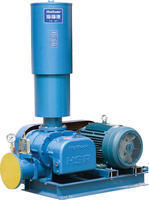 The Roots blower is a rotary volume blower, which uses two leaf rotors to perform relative motion in a cylinder to compress and convey a gas rotary compressor. The blower is simple in structure, easy to manufacture, suitable for gas delivery and pressurization in low pressure applications, and can also be used as a vacuum pump.
The Roots blower is a rotary volume blower, which uses two leaf rotors to perform relative motion in a cylinder to compress and convey a gas rotary compressor. The blower is simple in structure, easy to manufacture, suitable for gas delivery and pressurization in low pressure applications, and can also be used as a vacuum pump. Introduction Chinese: Roots Blower English: Roots blower
Type: Direct and points associated with the principle of <br> <br>
The Roots blower is a rotary volume blower, which uses two leaf rotors to perform relative motion in a cylinder to compress and convey a gas rotary compressor. This type of compressor keeps the two rotors in mesh by the synchronizing gear at the rotor shaft end. Each concave surface of the rotor forms a working volume with the inner wall of the cylinder. During the rotation of the rotor, the gas is taken away from the suction port. When moving to the vicinity of the exhaust port and the exhaust port, the pressure is higher due to the higher pressure. The gas returns, at which point the pressure in the working volume suddenly rises and the gas is then delivered to the exhaust passage. The two rotors work alternately in turn. The two rotors do not contact each other, and they are sealed by tightly controlled gaps. Therefore, the discharged gas is not contaminated by the lubricating oil.
structure
Due to periodic suction, exhaust, and instantaneous isovomatic compression, the velocity and pressure pulsations of the gas flow cause large aerodynamic noise. In addition, gaps between the rotors and between the rotor and the cylinder cause gas leakage, thereby reducing efficiency. The Roots blower has a displacement of 0.15-150 m/min and a rotational speed of 150-3000 rpm. The single-stage pressure ratio is usually less than 1.7 and can reach a maximum of 2.1, and can be used in multiple stages.
Features and others
Features:
Its biggest feature is that when the pressure is used to adjust within the allowable range when the use of the flow changes little, a wide range of pressure selection, with forced gas transmission characteristics. The medium contains no oil during delivery. Simple structure, easy maintenance, long service life, small machine vibration.
medium:
The Roots blower transports clean air, clean coal gas, sulfur dioxide and other inert gases. Due to these characteristics, it can be widely used in the metallurgy, chemical, fertilizer, petrochemical, instrumentation and building materials industries.
Working principle and advantages and disadvantages
A rotary compressor that uses two leaf rotors for relative motion in a cylinder to compress and deliver gas. This type of compressor keeps the two rotors in mesh by the synchronizing gear at the rotor shaft end. Each concave surface of the rotor forms a working volume with the inner wall of the cylinder. During the rotation of the rotor, the gas is taken away from the suction port. When moving to the vicinity of the exhaust port and the exhaust port, the pressure is higher due to the higher pressure. The gas returns, at which point the pressure in the working volume suddenly rises and the gas is then delivered to the exhaust passage. The two rotors work alternately in turn. The two rotors do not contact each other, and they are sealed by tightly controlled gaps. Therefore, the discharged gas is not contaminated by the lubricating oil. The blower is simple in structure, easy to manufacture, suitable for gas delivery and pressurization in low pressure applications, and can also be used as a vacuum pump. Due to periodic suction, exhaust, and instantaneous isovomatic compression, the velocity and pressure pulsations of the gas flow cause large aerodynamic noise. In addition, gaps between the rotors and between the rotor and the cylinder cause gas leakage, thereby reducing efficiency. The Roots blower has a displacement of 0.15-150 m/min and a rotational speed of 150-3000 rpm. The single-stage pressure ratio is usually less than 1.7 and can reach a maximum of 2.1, and can be used in multiple stages.
Difference with centrifugal fan
The difference between them is relatively large:
1. The working principle is different. Centrifugal fans use curved vanes. The centrifugal force blows the gas to the casing. The Roots blower uses two 8-shaped vanes. The clearance between them is very small. The squeezing of the blade squeezes the gas to the outlet.
2. Due to different working principles, their working pressures are generally different. Roots blowers have higher outlet pressure and centrifugal fans are smaller.
3, the air flow is different, the general Roots blower is used in places where the air volume is not high but the pressure requirements are high, while the centrifugal fan is used in places where the pressure requirements are low and the air volume requirements are large.
4, the manufacturing accuracy is not the same, Roots blower requires high precision, the assembly requirements are also very strict, and centrifugal fan is relatively loose. Of course, there are some minor differences.
Hot Product Laser Cutting Machine
Chittak has many other pipe processing products:Automatic 3D Laser Pipe Cutting Machine, Handheld Laser Welding Machine, Saw Blade Pipe Cutting Machine, Pipe Bending Machine , Pipe Chamfering Machine ,Metal Plate Cutting Machine and Accessories like Saw Blade etc.. Welcome your enquiry and hope build the business relationship with you !
FG-220 laser cutting, pipe cutting machine, pipe cutter near me
GUANGDONG CHITTAK INTELLIGENT EQUIPMENT CO.,LTD , https://www.chittakcutting.com